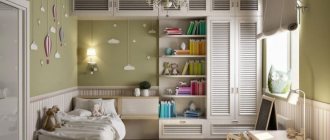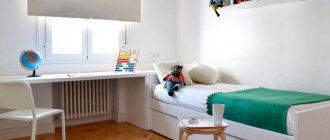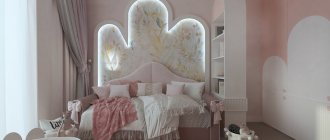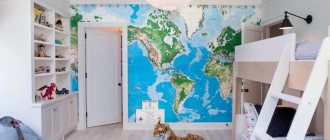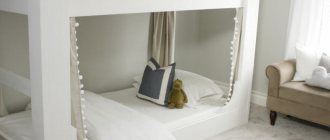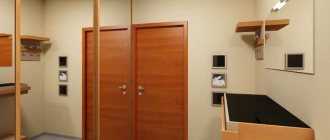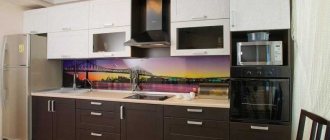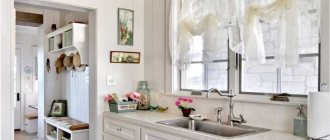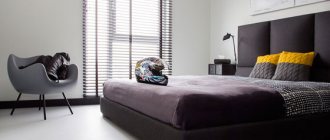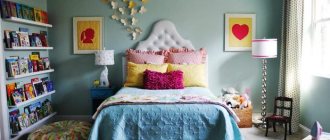Before you begin the exciting and time-consuming process of decorating a children’s space, answer a few questions:
- Who will live - a boy or a girl?
- How many children do you want to accommodate?
- What age is the child/children?
- If there are several children: are common areas possible?
- What are your interests, hobbies, favorite activities?
- What kind of room interior will the child like?
The answers to these questions will help you outline an imaginary plan and relate it to real needs and opportunities.
Visual lack of crowding
As for visual relief from the feeling of cramping, it can be softened to one degree or another by using large wall mirrors and mirrored facades on the wardrobes installed in the children's room.
Today there are a huge number of successful options for arranging such an interior, which is easy to see from the numerous photos of a child’s room of 10 square meters. m., published on the World Wide Web.
Features of decoration and room design
The finishing materials for the nursery are predominantly natural and do not emit harmful substances. The floor is preferably wooden or laminated; it is often heated; the colors are chosen two or three shades darker than the walls. You should not use a stone - it is quite cold, most often slippery, and it is easy to get injured if you fall. Plastic, wooden panels, and washable wallpaper are suitable for walls. Ordinary paper ones are not suitable for kids who like to draw on them. It is better to avoid overly bright, expressive photo wallpapers - they negatively affect the delicate child’s psyche, and can generally frighten children. Neutral motifs are preferred - discreet geometric shapes, floral patterns, stripes, etc. The ceiling, depending on the design idea, is made of wood, plasterboard or tension, but is always a little lighter than the walls. Sometimes several levels are made, each of which is brightly lit so that the room does not seem cramped.
The carpet chosen is large - almost the entire room, not reaching the walls 20-25 cm. Such an item will successfully combine the main furniture - a bed, a wardrobe, a table. In another option, medium-sized rugs highlight one or two zones. All available textiles are selected to match the color scheme, texture, and design. Preferably natural fabrics that are easy to wash in a machine. The room should fully reflect the child’s hobbies: an easel for a young artist, a piano or guitar for a musician, a small winter garden for a future agronomist, etc. In a teenage room, zoning is done using a wooden partition with stained glass windows, but this is not recommended for younger children.For boy
The main colors here are usually gray, blue, brown, light blue. In a little boy’s bedroom there is often a sports corner with a wall bars, swings, rings, and a slide; for a teenager, a narrow gymnastic bench and several dumbbells will take the place of the swing. The interior style here is preferable to marine, modern. The baby will like a crib in the shape of a car or a ship; an older one will be interested in a star map covering the entire ceiling, photo wallpaper with a realistic car, or a spaceship. The windows here are decorated with simple straight curtains; blinds of any configuration are suitable. A chandelier in the shape of a helicopter will complement the overall picture in an original way.
The furniture chosen is quite rough, strong, “masculine”, and there is practically no small decor here.
For girl
For a girl's room, the standard furniture set is complemented by a dressing table. Sometimes there is an aquarium or a cage with a hamster here - girls often like to tinker with animals. The design style is romantic, classic, the colors preferable are pink, orange, white and yellow. Here, multi-layered draperies on the windows, a canopy over the bed, and a valance under the dressing table will fit into the theme. For the little one, the room will be decorated with fairy fairies, doll houses, butterflies, bunnies and kittens in pastel shades. A teenage girl will prefer photos of her favorite musicians, cute souvenirs, posters with shots from youth films. The mirror in the girl’s room is located above the dressing table, less often it is made “full-length”, which is very convenient for sports activities and independent dance training. Elegant furnishings will complete the interior.
For two children
If there is a large difference in age, work stations are placed further away from each other so that the younger one does not interfere with the older one’s work. Children of different sexes are sometimes partially or completely selected furniture of different colors - this is especially convenient with a symmetrical arrangement. The space above the bed and study area is also designed differently - each child can do this with the help of adults. It is advisable to choose one main color for the room. In a corner room with two windows, they are used as much as possible, placing work tables along each one, separating the zones with a corner cabinet, screen, and color. It is preferable to make separate places for children of different sexes to play - after all, girls prefer to play with soft toys, dolls in strollers, and toy houses, and boys prefer to play with robots, cars, and railroads. If the children’s interests coincide in some way, the play area is made common, taking into account the wishes of both parties as much as possible, including regarding the color scheme.
A bunk bed is often placed in a narrow room, where it is not possible to place two beds opposite each other.
Advantages of a small children's room
In a small room of his own, the child sees a wide range of advantages, namely:
- it corresponds to his growth and self-perception, thanks to which he creates a feeling of comfort and lack of danger. Such qualities are especially highly valued by children of adolescence;
- in a small room, no one will “temporarily” install an unnecessary bedside table or an old refrigerator. In addition to everything, cleaning there is not at all difficult, which will allow adults to quickly teach their child to collect toys and wipe dust from furniture and window sills.
Methods for zoning a children's room
Designers have long come up with many tricks for zoning rooms. You don't even have to “reinvent the wheel.”
Mobile partitions
Mobile partitions are the simplest tool for zoning. For example, folding screens. They can be removed during the day, and put back in at night or for classes.
Such partitions also differ from stationary structures in that they are visually lighter. This means they look less bulky in small rooms.
Plasterboard structures
From plasterboard you can create structures of any complexity and configuration: from lightweight interior walls to elegant semi-arches or low racks.
Plasterboard structures, unlike mobile partitions, cannot be folded or removed. But they have another advantage: you can build a whole storage system for things inside. And use the surface of low partitions instead of a table or shelf.
Cabinets and shelving
Now there are a lot of furniture options suitable for dividing a room. Of course, these are not bulky wardrobes in the ceiling. But racks with shelves for books and cute little things look lighter and immediately give the nursery a certain style and mood.
Pay attention to modular designs. Especially those that have access from two sides
They can easily replace a closet, chest of drawers or pencil case. And in modern interiors they can be played out in an interesting way with the help of decorative lighting.
Curtains
Thick curtains are usually built into the ceiling instead of a partition. More precisely, the cornice is mounted into a plasterboard structure. But this also has its advantages and disadvantages.
The advantage is that the curtains are easy to close and open as needed. They can always be removed for washing or replaced with new ones if children want to refresh the interior.
Disadvantage: textiles attract dust, get dirty easily and are a fire hazard. This is not the best option for small children. So first weigh the pros and cons.
Visual zoning
Visual techniques include zoning with materials, colors and textures. This also includes podiums and ceiling structures.
But in the case of dividing a children's room for children of different sexes, it is better to use such tricks as an addition, and not as a basis. Light and color alone can change the perception of a room, but not create two private corners.
But with the help of a podium and lighting, you can perfectly highlight a play or work area.
It is necessary to take into account the wishes of the child
It is important to keep in mind that children especially enjoy spending time in their room if they have had good advice from adults before settling on a particular project.
At the same time, it is advisable to give the child the right to one way or another contribute to the future design of his room, and then the girl’s nursery will constantly delight her, and not cause irritation and distress.
Layout options
1. 2*5 meters, rectangular, window opposite the door. Door on the side.
The wardrobe and bed are located along the wall, away from the window. The workplace is by the window. This will ensure maximum access to daylight. There is enough free space for games.
2. Square. The door is in the corner opposite the window. The main furniture load falls on the side opposite the door. The sleeping place is closer to the door.
3. A preschool boy’s room can be designed in a specific thematic style. The future man will certainly like a marine, automotive or sports theme.
A large image of your favorite cartoon character on the wall will delight any child.
Grown-up boys are often interested in sports, robots, gadgets, cars, and superheroes.
Achievements are important for the self-esteem of a future man. His awards and diplomas should be visible. An excellent addition to the interior will be shelves with diplomas, medals and other indicators of his success. Other bedroom design options for a preschool boy can be viewed here.
4. Room for a girl. The marshmallow pink room theme is a classic that any girl will appreciate.
Girly themes in interior design - ponies, fairies, princesses, castles.
The sleeping place for the princess is a royal bed. Some decor in the form of a canopy with lace will suit the taste of any young lady.
A teenage girl can be offered any girly theme to suit her taste. Be sure to think about a place with a mirror or a dressing table with her.
Usually a girl's room has a large number of accessories. Find a place to store jewelry and clothes. Bedroom design options for a 7-year-old girl and a teenage girl can be viewed in our photo collections
Don't forget about zoning
Even in a cramped room, willy-nilly, division into functional zones occurs. As a rule, they appear spontaneously and are limited to pieces of furniture standing there.
Features of the arrangement
No matter how strange it may sound, children feel more comfortable in small rooms than in spacious rooms. There are several big advantages of a small nursery:
- since few objects can be placed in the room, it is easier for the child to maintain cleanliness and order;
- a room with an area of 10 square meters is designed only for the baby, so the interior can be playful, fairy-tale, themed. It is important to take into account the wishes of the child;
- It’s easier to change the environment as the children get older. In a small room, cosmetic renovations are easy to do, and replacing individual pieces of furniture is inexpensive.
The influence of zoning on children's development
At the same time, zoning, made on the basis of rational considerations, taking into account the age and hobbies of children, will certainly accelerate their development, affect their character and ability to achieve their goals. At the same time, planned zoning helps prevent many conflicts and scandals, since it removes many controversial issues.
Ceiling design
When choosing a ceiling, it is difficult to resist installing a tension ceiling. It captivates with its stylish appearance and convenience. In addition, you can get creative with patterns and colors. Of course, with such a ceiling the design looks more luxurious. And if possible, you can please yourself and your child.
The interior seems more complete and complete when the stretch ceiling is made in the same color scheme as the walls.
The ceiling imitating the sky is no less beautiful. Miraculously, this creates the effect of true infinite height. Unfortunately, this will not go well with every design, and not everyone will like it. Some people will find such a ceiling uncomfortable.
And yet the main thing is that we must not forget about the unity of style!
For a high-tech room, a white glossy ceiling is suitable; in a minimalist-style nursery, a ceiling that matches the walls will look good.
And somewhere it is better to abandon the newfangled decoration and leave a simple, white-painted ceiling (New York, Paris, classics).
The order of things and personal territories
These include:
- daily cleaning of the room, as children from a young age get used to a certain order of things, getting a firm idea of where to keep toys and how to store clothes;
- children's disputes generated by their claims to certain areas of the room. Having received a certain area at their disposal, each child will feel like the owner of the territory, whose rights are recognized and respected.
Color and style
To properly decorate a children's room, follow the three-color rule. So that the variety of palettes does not catch your eye, take 3 colors as a basis. The choice depends on the design and style you choose for decoration. The presence of extraneous colors is allowed, but provided that their content does not exceed 10% of the entire room.
The main difficulty that owners of spacious children's rooms face is choosing a place for furniture.
Give preference to bright, light colors. Suitable for a boy:
- white;
- olive;
- blue;
- grey;
- lilac;
- beige.
Desk, bed, storage systems - all this should be placed in a rational way.
If a princess was born in your family, it is more advisable to decorate the room:
- red;
- pink;
- raspberry;
- peach;
- grey, beige or white.
In a spacious nursery, the designer has a lot of room to choose the colors and prints used to decorate the room.
If you need to accommodate a boy and a girl, you will have to choose something in between. Use visual zoning methods with different color shades. This combination of colors will allow you to create an unusual, original design in a children's room of 14 sq. m.
Most often, designers use the classic L-shaped furniture arrangement, which leaves the center of the room free.
When choosing a style for a children's room, pay attention to the following:
- shabby chic;
- Provence;
- classic;
- modern;
- high tech;
- minimalism;
- Scandinavian style.
Not only classic light colors are allowed, but also brighter shades that create a playful mood.
The incomparable advantage of minimalism, hi-tech and Scandinavian style is their versatility, the ability to be used in combination with other directions. These motifs are suitable for both adults, teenagers and children. The ability to use original slopes and directions makes these 3 styles the most popular.
A boy's children's room is traditionally more formal and mature.
Leisure area
Layout of a children's room 10 sq. m. should begin with the selection of a recreation area. Usually, a corner is allocated for her, away from the window, so that bright sunlight does not interfere with daytime sleep. If only one child will live in the nursery, then it is quite logical to buy for him a folding bed with a convenient drawer for storing sheets and blankets.
If two children live in the room, then it is worth buying a bunk bed for them. So that it does not take up too much space, it is advisable to choose a modern compact folding model.
Storage system organization
To systematize the storage of various children's things for their intended purpose, you need bedside tables, wall cabinets, and closed shelves. Free openings near windows can be filled with pencil cases.
Ceiling-height cabinets, including built-ins, are an ideal solution for using the real space of a small room upward, not outward.
Cabinets in the window area
Fun games area
The child traditionally spends a lot of time in the play area, so a boy’s nursery should be as comfortable and safe as possible. Boxes with toys should be arranged so that you don’t have to crawl under a cabinet or table to get them.
For teenagers, it makes sense to equip a horizontal bar and a simple exercise bike. If a student is overly interested in the computer, then you need to put a keyboard synthesizer or a bookcase in his room so that they distract him from the monitor. For girls, several mirrors are required.
Deciding on the zones in the nursery
The main areas of the nursery are equipped for:
- rest, sleep;
- games;
- creativity;
- changing clothes;
- study;
- sports activities.
When there is more than one child, the working or sleeping place is made separate for each, separating them as much as possible. If they are already large and of different genders, separate corners for changing clothes are required; the project provides for this in advance.
Positive aspects of proper space zoning:
- accustoms children to order - it is unlikely that it will be possible to place many objects here;
- the room seems more spacious - especially when its decoration is light;
- a separate work area helps you concentrate on your studies;
- if there are several children, each gets a personal territory.
Zoning is done using:
- sliding screens;
- arches;
- narrow shelving;
- curtains;
- podiums;
- differences in ceiling heights;
- screens;
- different colors of floors, walls, ceilings;
- pieces of furniture;
- local lighting.
For two children with similar interests, some areas are combined.
Sleeping and rest area
A fully rested child studies, grows, and develops well, so the comfort of a sleeping place is in the foreground. It is best to purchase an orthopedic mattress and the same pillow. The sleeping area is located against the wall or in the center of the room, separated from other places by a screen or a wardrobe. Sometimes it is arranged on a podium, but only if the child is not too small - otherwise it will be difficult for him to climb, and accidental injuries are possible during games. A nightstand and a small bedside table are placed nearby. For two children, a bunk bed is preferable, with the eldest usually sleeping on the top bunk. The structure must be stable so that it cannot be shaken or overturned. The ladder to the top is mounted from the end. For children over eight years old, a symmetrical loft bed is made - two sleeping places are placed one behind the other, there are ladders on both sides. Below are two separate work tables.
Study area
The computer desk is equipped with shelves, drawers for notebooks, books, stationery, educational toys. Here the child draws, sculpts, does appliqué, and makes handicrafts, and the schoolchild does homework. Here they hang a multiplication table, a class schedule, a geographical map, a board on which they write with chalk, etc. It is better to place this place near the window - for a right-handed student the light falls on the left, for a left-handed student - on the right. Separate work tables or one large one are placed for two people, the space for each is clearly separated and illuminated separately. If there is a well-insulated balcony or loggia, the study area is placed there - then the windows are decorated with roller blinds that will protect the eyes from the bright daytime sun. The balcony is partially or completely combined with the main room; the border is created using an arch, a “scattering” curtain.
The most practical table and chair are those that “grow with the child,” that is, adjustable in height.
Area for games and entertainment
A play area is needed up to 10-12 years old; it is often combined with a sports area, representing a rack with toys, a thick floor mat or gymnastics mat, ladders, and swings. Several poufs are placed here, inside of which it is also possible to put toys or a small soft sofa, also with spacious internal sections. Colored plastic storage boxes are placed on top of each other, a rack or a cabinet - you can’t do without them when there are a lot of toys. It is not recommended to install a TV in a child's bedroom - it distracts from studies and creative activities. If the item does exist, it is secured in a place convenient for viewing, where the likelihood of accidental breaking during games is minimal.
Sharp corners should also be avoided here, especially if children are small.
Area for handicrafts and modeling
In the work area, the child will do what he loves, that is, draw, sculpt animal figures, glue paper ships and assemble corn shells from matches. It is advisable to place a table for such activities near the window.
Instead, you can use a window sill if you cover it with a special overhead tabletop. Children's room 10 sq. m. for two children is usually equipped with a modular multifunctional system in which you can place a computer, table lamp, books and notebooks.
Tips for choosing furniture
The main thing that people pay attention to when choosing furniture is its environmental friendliness and safety for the child. Furniture should be made from natural materials - oak, walnut, pine, cherry, beech, larch, ash, MDF or chipboard, upholstery - from natural fabric.
For small rooms it is convenient to use designs that save space:
- installation of a sliding furniture system;
- a loft bed will combine the study area and the student’s bedroom;
- A 2-tier bed will minimize the sleeping area with comfort for children;
- a bed, sofa, table with drawers make it possible to put a lot of things and objects in them.
With minor modifications, the window sill can be turned into a learning or play area. This can be either a study table or a small sofa.
Wide choice of color options
If you paint a small children's room creatively and tastefully, it will visually expand by about one and a half times. Particularly successful in this sense would be an option with light walls and neutral-colored floors and ceilings.
Furniture can be enlivened with animal figures printed using photo printing. In order for the atmosphere to be truly childish, you need to select curtains, blankets and pillows for it accordingly.
Color spectrum
The color scheme depends on the gender, age, and personal preferences of the little residents - a baby will be frightened by dark contrasts, a girl will prefer yellow-pink shades, a boy will like violet-blue tones, teenagers of both sexes often choose black and white. It is important to take into account the location of the room’s windows: when they face the south, southeast, the colors are cold, even dark; when they face the north, northwest - extremely light, as warm as possible. The most popular:
- amaranth with eggplant;
- periwinkle with azure;
- beige with pale red;
- greenish-yellow with beaver;
- bronze with spring green;
- cherry with light olive;
- wisteria with fuchsia;
- purple with orange-yellow;
- amber with chocolate;
- cement gray with black and red;
- tangerine with pistachio;
- violet with slate blue;
- tomato with titian.
It is undesirable to use more than two or three colors in the interior of one room, but different shades are acceptable.
